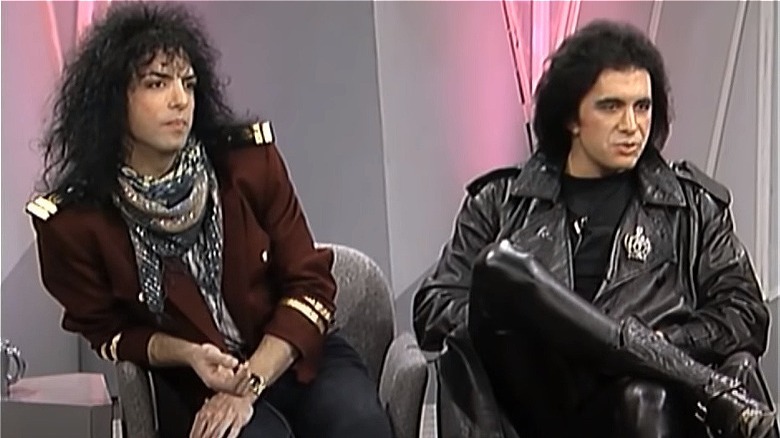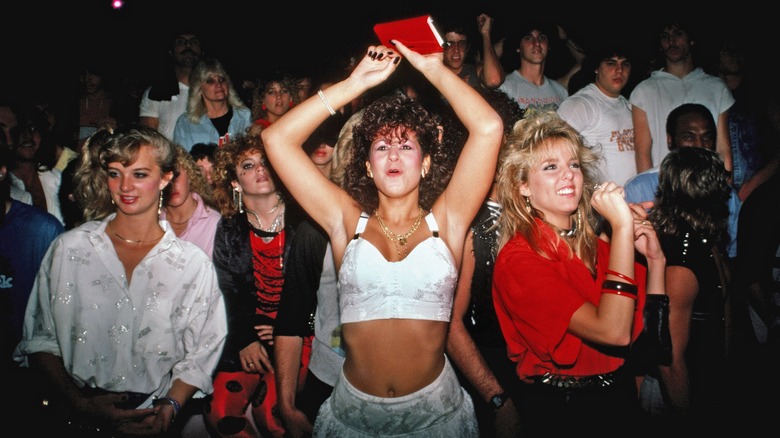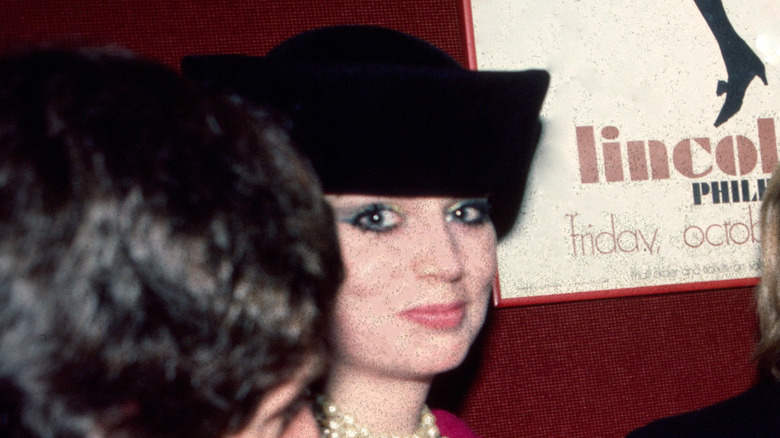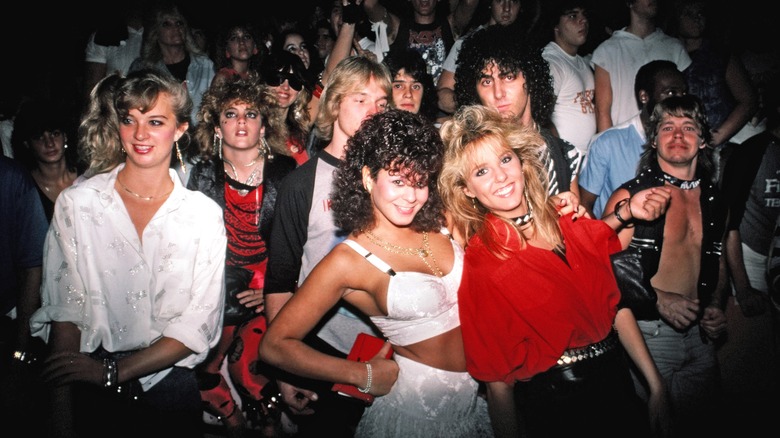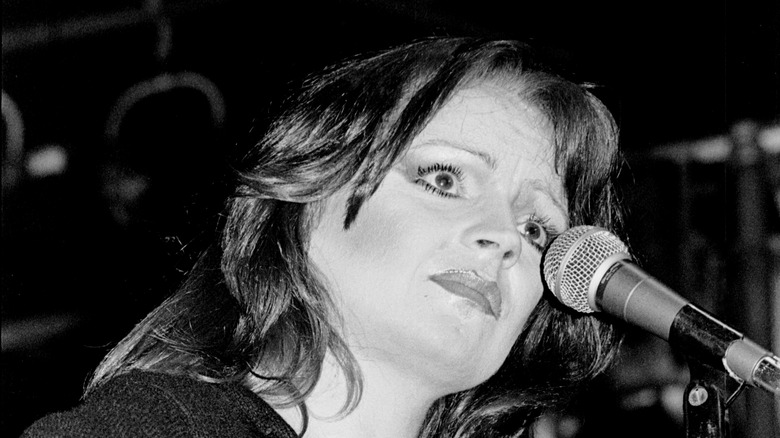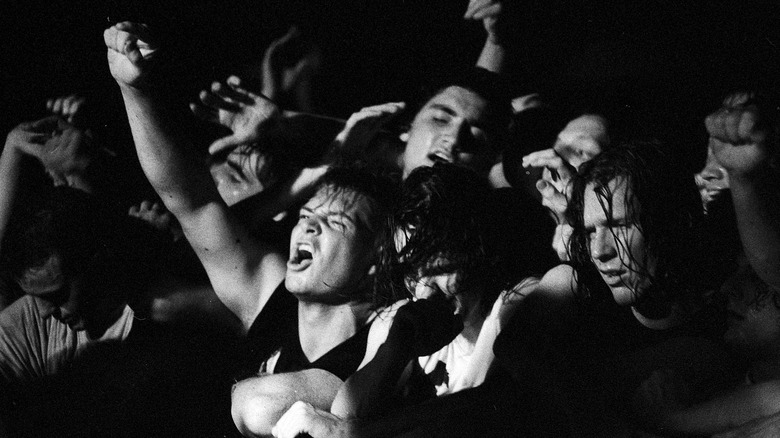What It Was Really Like To Be A Groupie During The 1980s
To some, the figure of the rock groupie represents artistic and personal freedom, not to mention wild and fun times. To others, that is only a thin veneer applied over a misogynistic, exploitative system that reduces women to objects. That relationship may have seemed all the more complicated in the 1980s, when intemperance seemed to be the name of the game, at least in the world of rock and roll.
Many groupies, however, have spent years maintaining that they were more than just hook-ups. Well into the 1980s, they were fulfilling artistic and emotional roles that went beyond the physical. For instance, Connie Hamzy, the Arkansas-based groupie popularly known as "Sweet, Sweet Connie," traveled with Van Halen during the 1988 Monsters of Rock tour, clearly acting as more than a one-off fling (though she later died in August 2021 without much fanfare). They had seriously complicated feelings about their roles, too, sometimes bucking the whole notion of the groupie title in the first place.
Many others encountered similarly complex situations backstage at rock shows and beyond, navigating the highs of hedonism and the artistic life and the lows of sexism, drug use, and more. Here's what it was really like being a groupie during the wild days of the 1980s.
Misogyny was rampant
Many groupies have spoken glowingly of their experiences backstage, while KISS singer (and now painter) Paul Stanley claimed to worship women to Oprah in a 1988 interview ... whereas bandmate Gene Simmons claimed to have gotten into rock for access to women. Others haven't been quite so complimentary. In fact, some of the same women who fondly recall their groupie eras also admit that they routinely faced misogyny. As Roxana Shirazi plainly put it in her memoir, "The Last Living Sl**," in the broader world, "A female is not defined in terms of her humanity, but in terms of her sex life." Those women, Shirazi argues, are treated poorly for wanting to have sexual encounters, while men are lauded for doing the same.
That attitude permeated — and perhaps still permeates — the world of rock and roll. As Shirazi told the Muses podcast, the misogyny she encountered in the music scene beginning in the 1980s persists to this day. "I want to be rock and roll," she said. "But sometimes I can't. I'm not allowed to be."
Bebe Buell, who was most active as a groupie in the 1970s before moving on to a music career in the 1980s, spoke damningly of the pervasive misogyny applied to groupies in an interview with Stay Thirsty. "I get really angry at these people who dismiss these girls as wh**** or groupies or crappy labels they want to throw at them. They were more than that," she said.
Some groupies found community
In many quarters, the image of the groupie is exceedingly shallow, based largely on the good times of making music and indulging in a variety of physical encounters and illicit substances. Yet, if that were always the case, then perhaps we wouldn't have stories of big-name groupies like Pamela Des Barres or the groupie phenomenon at all. Why would some people keep coming back to situations where they only experienced surface-level interactions with others?
Maybe because they weren't. While no one can rightfully speak for all groupies — who did often have to navigate misogynistic environments and people who routinely dismissed them as shallow hangers-on — sometimes the experience provided real benefit. A 2014 study published in Sexuality & Culture found that groupies in the 1980s metal subculture reported plenty of sexual encounters and instances of drug usage, but also found community and artistic fulfillment in their encounters. Moreover, those who were included in the study reported having fairly normal middle-class lives and looked back with affection on their admittedly risky behavior as youths.
That sentiment was echoed in an early '90s interview with Connie Hamzy (pictured), who was often known as "Sweet, Sweet Connie" after a callout in a Grand Funk Railroad song partially written about her. Speaking to Joan Rivers for the comedian's NBC talk show, Hamzy denied having a shallow, sex-only relationship with musicians and crew members in past years. "They're my dearest friends," she told Rivers. "They're basically my family."
Consent remained seriously muddled
By the 1980s, the figure of the groupie was well-established — but consent still wasn't. Some situations, to many people, were clear-cut problems, such as when underage teen girls entered the groupie realm and began performing very adult acts with decidedly adult men.
Lori Mattix, a teenage groupie in the 1970s, now has complicated feelings about her time with rock musicians. "I wouldn't want this for anybody's daughter," she told The Guardian. Meanwhile, writer Roxana Shirazi told The Guardian that, while she felt she was in control of her sexuality, "It's never possible to have full agency [as a groupie]. From the outset, the power structure is not equal."
For the wildly popular 1980s band Mötley Crüe, groupie consent was seemingly taken for granted. Jason Bryce, who briefly traveled with the band as a photographer's assistant, recalled one 1987 incident in which bassist Nikki Sixx told one groupie, "If you want to hang out with the Crüe, you've got to sort my young mate out," referring to the then 16-year-old Bryce (via "The Heroin Diaries: A Year in the Life of a Shattered Rock Star"). She did, but was she really there to make a connection with an unknown teen? In one of the moments that destroyed the band's reputation, Sixx has also claimed to have sexually assaulted a woman who was so intoxicated she couldn't give consent, implicating Mötley Crüe drummer Tommy Lee in the same incident. Yet Sixx has also insisted to Rolling Stone that all of Mötley Crüe's encounters with groupies were consensual.
Male groupies existed, but were rare
Much of the interplay between musicians and groupies was based on a single heteronormative set-up — that is, the musicians were men and the groupies were women. Female rockers often complained of the lack of male followers, and singer Susanna Hoffs of 1980s pop rock group the Bangles noted that even when men made it backstage, things didn't go much further than flirting. Yet, that wasn't strictly always the case. Though exceedingly rare, male groupies did exist in the 1980s.
One, Ian Wagner, was better known by the colorful moniker of "Pleather." Interviewed by fellow groupie Pamela Des Barres for her book, "Let's Spend the Night Together: Backstage Secrets of Rock Muses and Supergroupies," Pleather noted that, as a child, it took him some time to realize that female rock musicians were the exception, not the norm. In time, however, he became something of a fixture in the scene beginning in the late 1980s when he was as young as 15, touring and spending intimate time with all-female acts like the Pandoras, the Screaming' Sirens, and Courtney Love.
Yet, like female groupies, Pleather told Des Barres that things weren't always easy and that he had complicated feelings about his past experiences. "I did get treated badly by a lot of them," he said, yet "there isn't a single woman that I hold anything against. ... It was an honor for me to be around them for the short amount of time I was."
Drug use got very dark
In the 1980s, as in other eras, drugs of multiple varieties might have been offered up as a way to relax and get in with the band, but they also could take much away from groupies. Writing in her memoir "Miss O'Dell," groupie Chris O'Dell said that her substance use became so serious that she can't remember large stretches of time in the late 1970s and into the 1980s. Those years "were full of darkness and shame brought about by my ever-worsening addiction to alcohol and drugs. I call them my lost years," she wrote. In 2009, O'Dell told ABC News that she stopped using in 1988, after previous attempts at getting clean were derailed by peer pressure and accusations of being boring.
Others were not quite so fortunate, however. In previous decades, some groupies had died from drug overdoses, including the overdose death of Christina Frka — more widely known as "Miss Christine" — in late 1972, when she was only 22 years old.
Perhaps most notoriously, groupie Cathy Smith (pictured), who was associated with musicians like Gordon Lightfoot, had become a drug dealer by the 1980s. She gave comedian John Belushi the fatal mix of heroin and cocaine that killed him in 1982, reportedly administering it herself. In 1986, Smith pled no contest to the charge of involuntary manslaughter for her part in Belushi's tragic death.
HIV and AIDS was a concern, but only for some
By the early 1980s, it was clear that a new and deadly disease was circulating worldwide. Initially, many assumed that the disease, which seemed to attack a person's immune system and opened them up to any number of infections, was limited only to members of the LGBTQ community. Yet, as the 1980s wore on, it became increasingly difficult to deny that HIV and AIDS represented a serious health problem for everyone, though harmful misconceptions and stereotypes about who got HIV/AIDs and how they contracted the virus abounded for decades and created a truly messed up history of the disease.
By the mid-1980s, many understood that the virus was passed through sexual activity and shared needle use. Yet, it wasn't always clear that rockers and groupies were worried about infection. Even in 1988, Gene Simmons admitted to Oprah that he had connected with upwards of 2,000 women (via Best Life).
Yet, in 1991, Ozzy Osbourne told the Los Angeles Times that he understood contracting HIV/AIDS was a real possibility that had changed how he interacted with fans, including groupies. "But in the past I have [messed around]," he said. "We all have. It haunts me." Even then, Osbourne and other musicians interviewed by the newspaper noted that some groupies were so intent on connecting with famous rock stars that infection worries didn't seem to cross their minds, indicating a pattern of behavior that had clearly been going on for years.
Gender norms meant groupies were cut out of the creative side
While 1980s rock might have presented itself as the realm of boundary-pushing, fun-loving rebels, it also presented real barriers to creative women. Even Ian Wagner, the male groupie known as "Pleather," told fellow groupie Pamela Des Barres that he saw his relationships with female rockers in gendered terms. "I've subconsciously set up my entire life to take the traditionally feminine role in relationships," he said in Des Barres' book, "Let's Spend the Night Together." "When I say feminine, I mean the person who is seen as weaker to the outside world, but is really the one making things happen. Women make the world go 'round, but the men take the credit."
Pleather hinted at the broader notion that women were more likely to be categorized as groupies, which allowed others, from musicians to critics to journalists, to dismiss them without allowing for their role in the creative, music-making process. As Gretchen Larsen argues in Organization, this persistent othering shored up the stereotype of women as mere fans who only consume and never create.
Thus, it was often all too easy for groupies of the 1980s and other eras to be relegated to the role of hangers-on and not artistic forces in their own right. Of course, as the (admittedly small) group of female rock musicians in the 1980s, as well as ardent fans like Pleather, could tell you, stereotypes are rarely applicable to everyone.
Some groupies still had creative success
While some groupies weren't taken seriously by others, many weren't about to let that stop them. Pamela Des Barres, one of the most famous groupies in the 1970s and 1980s, even claimed she was a muse for big-name musicians like Keith Moon of The Who. She later told Salon that groupies, in general, weren't merely sex objects, but "friends, helpers, assistants, [and] guides."
For some, it was possible to transcend that supporting role and become musicians in their own right. In 1983, rock scene staple Cherry Vanilla (pictured) told Rian Keating that she found great purpose and fulfillment in her varied creative work, which included working as a publicist, actor, writer, and musician. Cherry Vanilla (born Kathleen Dorritie) was by then not just a famous classic rock groupie who had partied with the likes of David Bowie, but an established musician and publicist who went to what many considered extremes to promote her and others' work (though she admitted that her own album sales were disappointing).
Meanwhile, Bebe Buell, widely known for her 1970s modeling career and for conceiving daughter Liv Tyler with Aerosmith frontman Steven Tyler, has continued making music well into the 21st century. Earlier in her career, she even hit it off with rock legend Patti Smith, with whom she traded poetry that would eventually transition into the 1980s as Buell's songwriting and performing career. Debbie Harry, the lead singer of Blondie, has even described herself as a former yet powerful groupie.
Some groupies were dealing with significant trauma
The home lives of some groupies were presumably pretty complicated, like '70s-era Lori Mattix, who formed relationships with much older musicians while underage. While Mattix has often maintained that she gave full consent, one may wonder where her family was in all this. (As Mattix told Thrillist, her mother was a busy single mom who gave the okay to Jimmy Page to date her teenage daughter.)
Few faced dramatic upheaval as much as Roxana Shirazi (pictured), who was born in Iran and sent to England when she was just 10 to avoid growing political tensions in Iran. In 1980s Britain, she faced racism and bullying from schoolmates who targeted Shirazi for her skin color. She also endured physical abuse from her stepfather.
As she recalled in her memoir, "The Last Living SI**," Shirazi also found English culture uncomfortably distant. "People were cold and stilted, and didn't hug and kiss and laugh as much as Iranians did," she wrote. "My family was cut off from the sense of community and quality of life they'd once had." This led to her interest in rock, though she admittedly had her most notorious years starting in the 1990s. Yet her thoughts surely echo those of earlier groupies who flocked to concerts. "I never drank or did drugs — rock 'n' roll was my vice," Shirazi told MetalSucks. "So when my life was too hard for me to handle, I'd seek out bands to make it easier for me."
Grunge may have dimmed the groupie star
For much of the 1980s, it must have seemed like the groupie lifestyle was going strong. Yet, the rise of a new genre may have taken a considerable amount of shine off the groupie image. Enter grunge.
It's not that grunge bands didn't have adoring fans who wanted to get very close to musicians. Ahead of making Nirvana's third and final studio album, "In Utero," record producer Steve Albini told the band that they had to eschew drugs and groupies while recording, hinting that at least the occasional groupie made an appearance (via Louder). Meanwhile, other '90s groups certainly had groupies, and individuals like Roxana Shirazi were active during the 1990s and beyond. Yet some speculate that a growing awareness of consent and sexual assault put a damper on the lifestyle there as well.
The stripped-down yet increasingly popular world of grunge and '90s alt-rock didn't exactly play to the excess of the 1980s groupie lifestyle. According to John Walters of Newsweek, his visit to a concert backstage in December 1991 was decidedly tame. Maybe it's because he was with his sister Lorraine, but the show included famous bands like the Red Hot Chili Peppers, Pearl Jam, and Nirvana. Yet, no groupies were in sight on Walters' visit. Instead, he found Kurt Cobain standing around eating a bowl of cereal. The partner who was there — Cobain's future wife, Courtney Love — was a musician in her own right with a soon-to-be-released album.
If you or anyone you know has been a victim of sexual assault or needs help with addiction issues, contact the relevant resources below:
- Visit the Rape, Abuse & Incest National Network website or contact RAINN's National Helpline at 1-800-656-HOPE (4673).
- Visit the Substance Abuse and Mental Health Services Administration website or contact SAMHSA's National Helpline at 1-800-662-HELP (4357).

